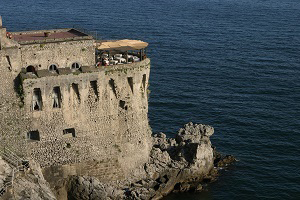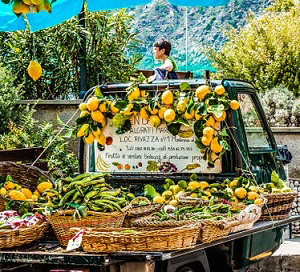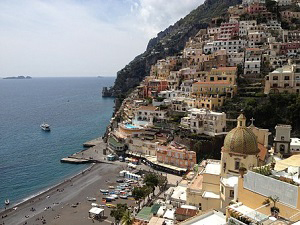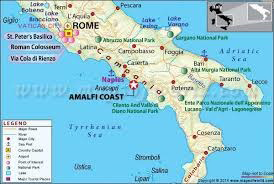The Amalfi Coast is a stretch of coastline on the northern coast of the Salerno Gulf on the Tyrrhenian Sea, located in the Province of Salerno of southern Italy. What does that mean? For most of us, it means the front of the ankle on the Italian boot.
The towns along the coast are nestled between the massive stone bluffs and the sea, making this area truly unique. So unique that it became a UNESCO World Heritage Site in 1997.
Because it could only be reached by sea, the Amalfi Coast remained relatively isolated until recent times.
That changed in 1815 when Ferdinand II of Bourbon began construction of the Amalfi Coast road, the Amalfi Drive. It’s the only road that runs along the coast and connects all the main towns from Positano in the west to Vietri Sul Mare in the east.
Today, a trip along the coastal road, now known as Highway 163, is a highlight of any visit to the Amalfi Coast. The locals call it the Nastro Azzuro, Blue Ribbon, because of the color of the sea, which is always in sight. The road clings to the cliff-face, climbing past headlands and dipping down to the sea to reach tiny fishing villages.
Until the 1950s, the Amalfi Coast remained the preferred haunt of celebrities, explorers, artists, writers, composers, and poets, who were attracted by its relative remoteness. It was made popular by John Steinbeck, who wrote about Positano, “it is a dream place that isn’t quite real when you are there and becomes beckoningly real after you have gone.” Today it’s one of Italy’s most popular tourist attractions.

Historic Places
Amalfi was founded in 4 BC as a maritime republic. For centuries Amalfi held the title as the trade capital of the Tyrhennian Sea, exporting wood, arms, iron, fruit, and wine to eastern markets in exchange for pearls, spices, jewels, perfume, textiles, and rugs, to then trade in the west. Because of its affluent reputation, Amalfi found itself under attack often, and a system of watchtowers was built beginning in nine AD.
Many of these towers still stand today. Twenty-two of them, to be exact. Of the towers remaining, many have been converted to businesses and government buildings. One, Norman Tower, is now a restaurant and another, Atrani Tower, is a nightclub. Dinner at Norman Tower should be on your to-do list.
There are also several monasteries dating back to the 1500s on the coast. They have been converted to hotels, suites and bed and breakfasts. Monastero Santa Rosa and Grand Hotel Convento di Amalfi are two of the finest. Both locations have restaurants, shops, and, of course, hotel rooms and suites.

The Lemons
With January lows of 50 degrees, it’s the perfect region for growing lemons. All along the coast, from February to October, dozens of lemon groves grown in terraced gardens dot the landscape.
As the symbol of the Amalfi Coast, lemons have been grown here since the Middle Ages when monasteries were built, and monks and nuns created the terraces to gain agricultural land.
The lemons on the Amalfi Coast are of a special type, sfusato amalfitano. They are large with thick skin that can be eaten as a refreshing snack in summer or used for sweets and candy. Yes, you can eat the peels, and they’re outstanding.
Also well-known is the sweet liquor limoncello, made from the lemon peels. You can find the limoneti, the lemon terraces, mainly on the seaside of the coast. The more you travel inland, the more the lemons disappear, and you begin to find chestnut groves and grape vineyards instead.

The Beaches
Although the Amalfi Coast is a favorite seaside holiday destination, this part of the Italian coastline has very few beaches.
Don’t expect to spend your time walking on long stretches of soft sand. On the Amalfi Coast, what is called a beach is often little more than a patch of pebbles or a rocky platform beneath the cliffs.
But don’t be discouraged because some of the world’s most enchanting bays, lapped by crystal clear waters, are located along the Amalfi Coast.
If you decide to rent a boat, you can reach the otherwise inaccessible coves of the Amalfi Coast and enjoy a little corner of paradise all to yourself for hours.
Of Note: The sun leaves most of the Amalfi Coast’s beaches in the early afternoon. So, for maximum hours of sunshine, have breakfast on the beach.

Where to Begin
With so much to see and do on the Amalfi Coast, it is hard to decide where to start. It makes sense to stay at a centrally located monastery. Many of them have terraced lemon gardens, and some have piazzas with local artisans selling their wares. Your concierge can help arrange boat rentals, dinner at the Norman Tower, and tours of the Isle of Capri.
However, when you choose to go, make sure you don’t schedule every moment of each day. Part of the charm of the Amalfi Coast is the relaxation factor. Take the time to enjoy your surroundings. Walk the narrow, ancient stairways. Just sit and watch the ships go by. Stop and smell the lemons. ~TPM
About Cynthia Lamberty—She was diagnosed with Chronic Culture Curiosity at a young age. The incurable disease has driven her across continents for the last 40-years. By sharing her experiences, she hopes to bring relief to CCC sufferers worldwide. Learn more about Cynthia at her website, Chris tian SEO Copywriter.
